Color Addition and Subtraction - Complete Toolkit
Objectives
- To identify the three primary colors of light and describe the result of mixing these light colors in equal and unequal intensity.
- To describe the significance of complementary colors, identify the three sets of complementary colors and use complementary colors and the principle of color subtraction to explain why an object appears the color that it does when viewed under white light.
- To predict the color appearance of an object when viewed under various combinations of red, blue, and green spotlights.
- To identify the three primary pigments and the light color that each absorbs and to use this knowledge to predict the light colors that such pigments would absorb or reflect.
- To use the principle of color subtraction to predict the light color(s) absorbed and transmitted by a color filter.
Readings from The Physics Classroom Tutorial
- The Physics Classroom Tutorial, Light Waves and Color Chapter, Lesson 2
Interactive Simulations
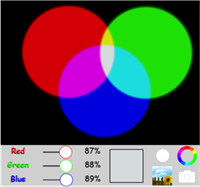 The Physics Classroom: RGB Color Addition
The Physics Classroom: RGB Color Addition
This simulation, recommended for use in the early phase of a unit on the physics of color, focuses on the mixing of red, green, and blue-colored lights on a screen. You can adjust the light intensity or remove one of the colors and see what happens. For more fun, students can upload their own image and view its RGB characteristics! This simulation keeps it pretty simple while reinforcing principles of color addition.
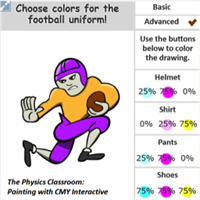 The Physics Classroom: Painting with CMY
The Physics Classroom: Painting with CMY
Here's the challenge as presented to students: "The football coach wants new uniforms and you’re in charge! BUT WAIT! You have to place the order by indicating the color of pigment to be produced in the fabric. You will have to understand some rules of color subtraction to get the right colors. Open our Interactive and start painting!" The Interactive and accompanying classroom exercise provides an exceptional introduction to how the primary colors of paints can be used to subtract primary colors of light and produce the intended appearance.
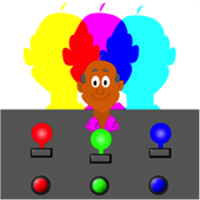 The Physics Classroom: Colored Shadows Interactive
The Physics Classroom: Colored Shadows Interactive
In this interactive, learners explore how colored lights become blocked and result in the formation of a “colored shadow’ on the screen. You can turn on 3 different lights to vary the resultant shadows. The simulation is a great way to demonstrate both color subtraction (as you block or take away some of the incident light) or color addition (combining of incident light colors). Teachers: The concept of colored shadows is counter-intuitive for students. We recommend coupling this simulation with a demonstration: see the Bruce Yeany Science demonstration below.
 Molecular Expressions: Color Separation Interactive
Molecular Expressions: Color Separation Interactive
This interactive tutorial from Florida State University explores how individual subtractive primary colors (yellow, cyan, magenta) can be separated from a full-color photograph, then reassembled to create the original image. Here’s what’s going on: color photographs and printed images are produced using just four colored inks/dyes – cyan, yellow, magenta (the subtractive primaries) and black. Mixing these colors plus black in varying proportions will produce just about any color for printing.
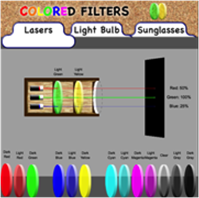 The Physics Classroom: Colored Filters Interactive
The Physics Classroom: Colored Filters Interactive
This activity simulates the colors produced by using filters. Colored filters are typically made of transparent pieces of dyed glass, plastic, or gelatin that have been treated to selectively transmit desired wavelengths and restrict others. This process is completely different from the interaction that happens when light hits an opaque object, and is also a far different phenomenon from transmission of light. This model lets students explore what different filters do to specific colors of light. With the Lasers tool, they learn that a filter selectively absorbs one or more primary colors of light. Now switch to the Light Bulb tab to explore how filters interact with white light. Last, you can check out the Sunglasses tab to investigate how a photo looks using color-tinted sunglasses.
Video and Animations
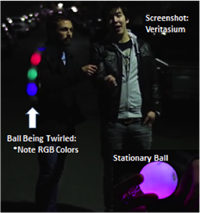 Veritasium: Persistence of Vision
Veritasium: Persistence of Vision
One problem with understanding color: the concepts aren’t intuitive because humans define “color” through perceptions that occur in our eyes and brain. In this short video, physicist Derek Muller looks at a plastic ball with three flashing LED’s inside (red, green, and blue). Turn the ball on and it appears to be a light violet color. But twirl it around in a circle and you can clearly see the 3 primary colors of light appear individually. What’s happening? The 3 lights are timed to flash one at a time, but so quickly that your eyes can’t “refresh” fast enough to perceive the changing colors. When swung in a circle, the color change occurs at different locations, so the colors don’t merge with one another.
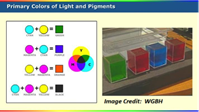 PBS Learning Media: Primary Colors of Light and Pigment
PBS Learning Media: Primary Colors of Light and Pigment
This resource combines video with animation to shed light on the difference between the primary colors of light vs. the primary colors of paint pigment. The LED light bulb video explores the addition of primary light colors. The gelatin video demonstrates clearly the absorptive properties of the 3 primary colors of light (red, blue, green). This video will help students apply the systematic approach of incident-absorbed-reflected to understand the principle of color subtraction.
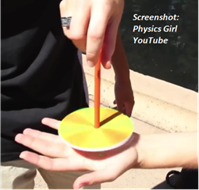 Physics Girl: Does This Look White to You?
Physics Girl: Does This Look White to You?
What’s the difference between mixing the primary colors of light and the primary colors of paint pigment? And how do computer screens use RGB color to produce the full array of colors we see? Or do they? This episode of “Physics Girl” does a nice job of explaining how light-sensitive cone receptors in the human retina work to perceive color. Physics Girl is Dianna Cowern, science outreach coordinator at University of California-San Diego.
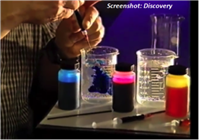 Discovery: Colours of LightDiscovery: Colours of Light
Discovery: Colours of LightDiscovery: Colours of Light
University of Toronto physicist Robin Marjoribanks takes a closer look at color, to go beyond the primary RGB colors of light. The first segment of the video shows why the secondary colors of light (cyan, magenta, and yellow) are called “subtractive”. The second half of the video shows a practical application – inkjet printer refills contain one cyan, one yellow, and one magenta bottle. What happens when you mix the cyan, magenta, and yellow together? The result is black.
Hands On Lessons and Activities
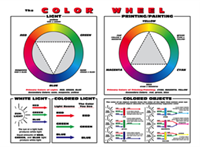 Sciences Education Foundation: It’s a Colorful Life
Sciences Education Foundation: It’s a Colorful Life
This multi-day unit, sponsored by General Dynamics, was designed as a set of 6 interlinked experiments to explore how colors are formed by light absorption and emission. Activities include physical models to experiment with additive and subtractive color; examining color mixing with a simple Power Point tool called CMYK; using magnification to examine the dot colors produced by an ink jet printer, and more. Detailed lesson plans, student activity guides, and background information are provided.
Labs and Investigations
- The Physics Classroom, The Laboratory, Color Addition
Students use a Shockwave application to explore the result of mixing two or more primary light colors in equal and unequal intensities.
- The Physics Classroom, The Laboratory, Taking Away from RGB
Students use cyan. magenta, and yellow highlighters to mix primary pigments together on paper and observe the result. They then use the principle of color subtraction to explain the result.
- The Physics Classroom, The Laboratory, Painting with CMY
Students use a Shockwave application to explore the effect of using cyan, magenta, and yellow pigments in order to create a desired color appearance.
- The Physics Classroom, The Laboratory, Filtering Away
Students view colored numbers through colored filters and explain the resulting appearance using principles of color subtraction.
Link: http://www.physicsclassroom.com/lab#light
Demonstration Ideas
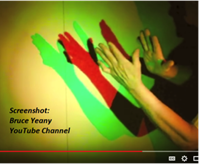 Bruce Yeany Science: Colored Light Shadow-Additive Light Mixture
Bruce Yeany Science: Colored Light Shadow-Additive Light Mixture
Pennsylvania science teacher Bruce Yeany brings us a nicely-shot video that can be used as a warm-up or as a low-cost classroom exploration. It requires 3 LED lights – (one red, one blue, one green) and a “Magic Lighting” remote controller device. Aim all 3 lights at the same spot and white light is produced. But block one of the lights and different-colored shadows appear on the wall. You can also try aiming only two colors at the same spot (see photo, where red and green lights together produce a yellow spot on the wall). Now create shadows with your hands and you will see the original two colors appear!
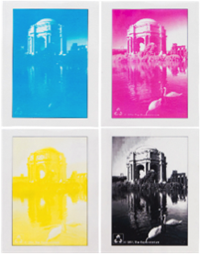 Exploratorium: The Three Little Pigments
Exploratorium: The Three Little Pigments
Here’s an inexpensive way to investigate how light and color interact by overlaying cyan, magenta, yellow (the secondary colors of light), and black transparencies. This activity from the Exploratorium provides the high-resolution images. All you need is a color printer that will print on acetate, a bright light source such as a projector (a sunny window will do). Depending on where you look on the acetates, various colors and intensities are subtracted from the white light.
Minds On Physics Internet Modules:
The Minds On Physics Internet Modules are a collection of interactive questioning modules that target a student’s conceptual understanding. Each question is accompanied by detailed help that addresses the various components of the question.
- Light and Color, Ass’t 3 - Primary Colors of Light
- Light and Color, Ass’t 4 - Complementary Colors of Light
- Light and Color, Ass’t 5 - Color Subtraction
- Light and Color, Ass’t 6 - Pigments
- Light and Color, Ass’t 7 - Pigments and Color Subtraction
- Light and Color, Ass’t 8 - Filters
- Light and Color, Ass’t 9 - Shadows
Concept Building Exercises:
- The Curriculum Corner, Light and Color, Reflection, Transmission and Color
- The Curriculum Corner, Light and Color, Color Addition and Subtraction
- The Curriculum Corner, Light and Color, Viewed in Another Light
- The Curriculum Corner, Light and Color, Pigments and Paints
- The Curriculum Corner, Light and Color, Shadows
Problem-Solving Exercises:
- The Calculator Pad, Light Waves, Problems #10 - #25
Link: http://www.physicsclassroom.com/calcpad/light/problems
Science Reasoning Activities:
- Shedding Light on Light Bulbs
Link: http://www.physicsclassroom.com/getattachment/reasoning/light/src36.pdf
Real Life Connections:
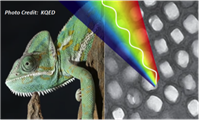 Nature’s Mood Rings: How Chameleons Really Change Color
Nature’s Mood Rings: How Chameleons Really Change Color
Chameleons are among the most brilliantly-colored animals on the planet. But until last year, scientists had it all wrong about how the reptiles accomplish their color-changing feats. This beautifully filmed video from KQED uses ultra-HD and clips from electron microscopes to show what’s really going on. Just beneath the chameleon’s skin is a layer of cells called “iridophores”, microscopic salt crystals 130 nanometers across, that are arranged in a 3D lattice like oranges on a fruit stand. When light hits this below-the-skin layer, some wavelengths are absorbed and some are reflected. BUT WAIT! The chameleon has the ability to change the iridophore lattice…..and THIS is what produces the amazing array of color.
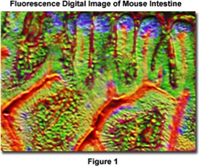 Microscopy U: Digital Imaging-New Opportunities for Microscopy
Microscopy U: Digital Imaging-New Opportunities for Microscopy
The explosive growth in digital imaging technology is worth your students’ attention. The job opportunities for specialists with degrees in optical microscopy are good right now. This article explores how newer technologies are applied to image capture.
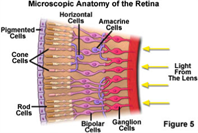 Molecular Expressions: Human Vision and Color Perception
Molecular Expressions: Human Vision and Color Perception
For students wanting to take a deeper dive into the human eye and its unique mechanisms for perceiving color, here’s a great tutorial from Florida State University’s Optical Microscopy Primer on the physics of light and color. The HTML tutorial takes you through the anatomy of the eye, function of the cornea, retina, cone and rod cells, and the basics of visual abnormalities.
Common Misconception:
- The Color is in the Light
Students will have preconceived notions that the color an object appears is solely dependent upon the object itself. In affect, they believe that the color is in the object. The truth that you wish to convey is that the color is in the light that is reflected from the object. The object’s role is to absorb a collection of wavelengths (colors) from the collection of wavelengths that are incident upon the object. What light colors are not absorbed are reflected to the observer’s eye to produce its color appearance. It is in this sense that we believe that the color is in the light. To helps students understand this object-light interaction, it is often helpful to emphasize the following three important questions … in order: What color(s) of light is/are incident on the object? What color(s) of light is/are absorbed by the object? What color(s) of light is/are reflected by the object to the observer’s eye? This systematic approach of incident-absorbed-reflected will assist students in understanding the principle of color subtraction.
- The Importance of Nouns
Both teachers and students will be using a lot color adjectives during this unit. Adjectives like red, blue, green, cyan, magenta, and yellow are used to modify nouns like light, shirt, paper, object, etc. Be mindful of your language; do not drop the nouns that the color adjectives modify. And be watchful of your students’ language, persistently pressing them to include nouns in both their speech and their attention. As students begin to drop the nouns, they will begin to make assertions like cyan is blue and green (which is true if they are referring to cyan light being equivalent to an equal mixture of blue and green light). But students will then begin to confuse themselves and start asserting (falsely) that cyan pigments absorb blue and green light. Catch this thinking and quickly correct them by helping them to ask the three important questions in order: What color(s) of light is/are incident on the object? What color(s) of light is/are absorbed by the object? What color(s) of light is/are reflected by the object to the observer’s eye?
- Physics vs. Art
Students have learned from their art teacher that the three primary paint colors and red, blue, and yellow. But in keeping with Misconception #2 above, they likely dropped the noun paint and concluded that red, blue, and yellow are the primary colors. They are thus quite confused to learn that red, green, and blue are the three primary colors. Once more the noun in this previous sentence was dropped … as red, green, and blue are the primary colors of light. This confusion can be quickly be resolved if you insure students that physics teachers talk about light and art teachers talk about paints. The confusion will arise later in this unit when you identify the three primary pigments as cyan, magenta, and yellow. Help students relate to these three pigment colors by associating them with the three ink colors present in most modern printing devices. The cyan that we physics teachers speak of is similar to the artist’s blue. The magenta that we physics teachers speak of is similar to the artist’s red. And the yellow that we physics teachers speak of is the same as the artist’s yellow.
Standards:
A. Next Generation Science Standards (NGSS)
Performance Expectations
- Middle School – MS-PS4-2: Develop and use a model to describe that waves are reflected, absorbed, or transmitted through various materials. [Clarification Statement: Emphasis is on both light and mechanical waves. Examples of models could include drawings (ray diagrams), simulations, and written descriptions.
Disciplinary Core Ideas - Middle School Physical Science - Waves - Electromagnetic Radiation
- MS-PS4.B.1: When light shines on an object, it is reflected, absorbed, or transmitted through the object depending on the object’s material and the frequency of the light.
- MS-PS4.B.3: A wave model of light is useful for explaining brightness, color, and the frequency-dependent bending of light at a surface between media.
Disciplinary Core Ideas - Middle School Life Science: Information Processing
- MS-LS1.D.1: Each sense receptor responds to different inputs (electromagnetic, mechanical, chemical), transmitting them as signals that travel along nerve cells to the brain. The signals are then processed in the brain.
Crosscutting Concepts
High School: Structure and Function
- Investigating or designing new systems or structures requires a detailed examination of the properties of different materials, the structures of different components, and connections of components to reveal its function and/or solve a problem.
Middle School: Patterns
- Macroscopic patterns are related to the nature of microscopic and atomic-scale structure.
Science and Engineering Practices
Practice #2: Developing and Using Models
- Develop and/or use a model to generate data to support explanations, analyze systems, or solve problems.
- Use a model to provide mechanistic accounts of phenomena.
Practice #6: Constructing Explanations
- Construct an explanation based on valid and reliable evidence obtained from a variety of sources (including students' own investigations, models, theories, simulations, peer review) and the assumption that theories and laws that describe the natural world operate today as they did in the past and will continue to do so in the future.
Practice #8: Obtaining, Evaluating, and Communicating Information: High School
- Communicate scientific ideas and information (e.g., about phenomena and/or the process of development and the design and performance of a proposed process or system) in multiple formats (including orally, graphically, textually, and mathematically).
- Critically read scientific literature adapted for classroom use to determine central ideas and obtain scientific/technical information.